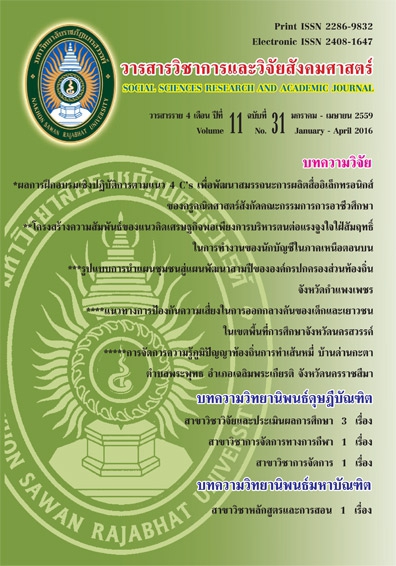การเปรียบเทียบการเห็นคุณค่าในตนเองของการเรียนโดยใช้วิธีการเรียนแบบพิพาท เชิงสร้างสรรค์กับการเรียนแบบปกติของนักเรียนชั้นมัธยมศึกษาปีที่ 3; The Comparison of Self-Esteem by Using Constructive Controversy and the Conventional Approach of Mattayomsuksa 3 Stud
Main Article Content
Abstract
บทคัดย่อ
การวิจัยครั้งนี้ มีวัตถุประสงค์เพื่อเปรียบเทียบ 1) การเห็นคุณค่าในตนเองก่อนและหลังเรียน
ของนักเรียนที่เรียนโดยใช้วิธีการเรียนแบบพิพาทเชิงสร้างสรรค์ 2) การเห็นคุณค่าในตนเองก่อนและหลังเรียนของนักเรียนที่เรียนโดยใช้วิธีการเรียนแบบปกติ และ 3) การเห็นคุณค่าในตนเองของนักเรียนที่เรียนโดยใช้วิธีการเรียนแบบพิพาทเชิงสร้างสรรค์กับการเรียนแบบปกติ กลุ่มตัวอย่างที่ใช้ในการวิจัยคือนักเรียนชั้นมัธยมศึกษาปีที่ 3 โรงเรียนพิจิตรพิทยาคม ดำเนินการวิจัยโดยทำการวัดการเห็นคุณค่าในตนเองก่อนการทดลองด้วยแบบวัดการเห็นคุณค่าในตนเองแล้วเลือกกลุ่มตัวอย่างดำเนินการวิจัยมา 2 ห้องเรียน ที่มีคะแนนจากการวัดการเห็นคุณค่าในตนเองก่อนการทดลองไม่มีความแตกต่างกันทางสถิติ แล้วสุ่มเป็นกลุ่มทดลองที่เรียนโดยใช้วิธีการเรียนแบบพิพาทเชิงสร้างสรรค์ จำนวน 55 คน และกลุ่มควบคุมที่เรียนโดยใช้วิธีการเรียนแบบปกติ จำนวน 50 คน เครื่องมือที่ใช้ในการวิจัย คือ 1) แผนการจัดการเรียนรู้วิธีการเรียนแบบพิพาทเชิงสร้างสรรค์ 2) แผนการจัดการเรียนรู้แบบปกติ และ
3) แบบวัดการเห็นคุณค่าในตนเอง ใช้เวลาในการจัดกิจกรรมการเรียนรู้โดยใช้วิธีการเรียนแบบพิพาทเชิงสร้างสรรค์และวิธีการเรียนแบบปกติ วิธีเรียนละ 14 ชั่วโมง รวมเวลาการวัดการเห็นคุณค่าในตนเอง วิเคราะห์ข้อมูลโดยใช้ค่าเฉลี่ยเลขคณิต ส่วนเบี่ยงเบนมาตรฐานและการทดสอบที
ผลการวิจัยพบว่า
1. นักเรียนที่เรียนโดยใช้วิธีการเรียนแบบพิพาทเชิงสร้างสรรค์มีการเห็นคุณค่าในตนเองหลังเรียนสูงกว่าก่อนเรียนอย่างมีนัยสำคัญทางสถิติที่ระดับ .01
2. นักเรียนที่เรียนโดยใช้วิธีการเรียนแบบปกติมีการเห็นคุณค่าในตนเองหลังเรียนสูงกว่าก่อนเรียนอย่างมีนัยสำคัญทางสถิติที่ระดับ .01
3. นักเรียนที่เรียนโดยใช้วิธีการเรียนแบบพิพาทเชิงสร้างสรรค์มีการเห็นคุณค่าในตนเองหลังเรียนสูงกว่านักเรียนที่เรียนโดยใช้วิธีการเรียนแบบปกติอย่างมีนัยสำคัญทางสถิติที่ระดับ .01
Abstract
The research aimed to compare 1) self-esteem before and after learning of students using constructive controversy, 2) self-esteem before and after learning of students using the conventional approach, and 3) self-esteem of students of using constructive controversy and the conventional approach. The sample used in this study were Mattayomsuksa 3 students from Phichit Pittayacom school. The measurement of self-esteem before the experiment was done and the samples selected from two classes were graded on measurement of self-esteem prior to trial, with no statistically significant difference. Then they were randomized into an experimental group of 55 students using constructive controversy and a control group of 55 students using the conventional approach. The research instruments were 1) the constructive controversy plan, 2) the conventional approach plan, and 3) the self-esteem of students questionnaire the constructive controversy and the conventional approach learning took 14 hours each inclusive of self-esteem measurement. The results of testing were analyzed by using mean, standard deviation and t-test.
The results of the research were concluded as follows:
1. For the students using constructive controversy the self-esteem posttest scores were higher than their pretest scores at the statistically significant level of .01.
2. For the students using the conventional approach the self-esteem posttest scores were higher than their pretest scores at the statistically significant level of .01.
3. For the students using constructive controversy the self-esteem posttest scores were higher than the conventional approach the statistically significant level of .01.

